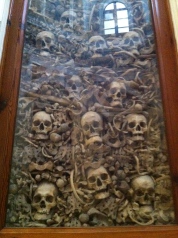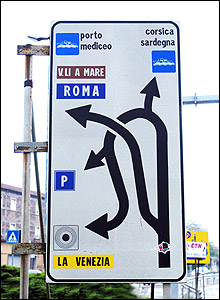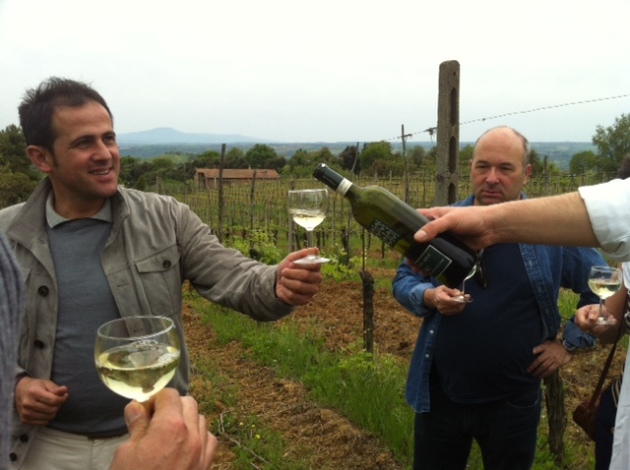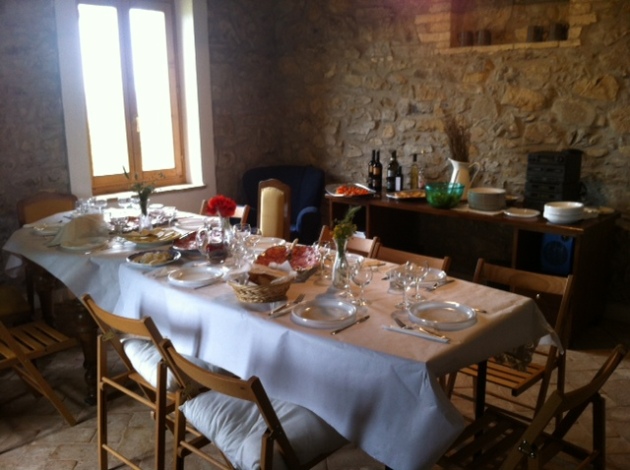It’s not that Italian women don’t care about food, but I never cease to be amazed by the passion and expertise that Italian men express regarding food.
A few weeks ago, we spent the weekend in one of the world’s elite wine regions, during the autumn wine crush.

Paradise? Yes, unless you are a vegetarian.
We were “helping” Aldo Marenco, a family-owned organic wine producer in la Langue of Piemonte Italy. Having just hand-picked the harvest, it was urgent that the grapes be crushed before they started to ferment. I am sure they would have done just find without our complete lack of expertise, but they graciously allowed us to watch and participate in this ancient ritual first hand.
Claudio Marenco is the son who took over the wine production from his father, Aldo. Today they grow and make the classic wines of this region – the soft and easy drinking Dolcettos and Barberras, as well as the region’s most prized vintage – Barolo.

The Bounty
It was Claudio’s idea when he took over the vineyard from his father to certify the wine production as organic. As a small family-owned/operated vineyard, many of the processes were already done by hand with close attention to the natural and ancient methods of growth. Grapes were hand-picked; not only because the uneven terrain demanded it, but also because machine-picking the grapes causes the delicate fruit to break prematurely, thus fermenting prematurely and not under the strict control of the vintner.

Me, working the farm, with Claudio’s help
As we “worked” alongside Claudio, Aldo and their neighbour, their hands coarse from working in the fields, the conversation more often than not turned to food. We were in the process of shoveling the leftover grape skins (“must”) from the press to a truck (to be taken to a grappa production facility), when the neighbor started extolling the many culinary uses for the must. First, he told us, you can wrap a local semi-soft cheese in the must – marrying the sharp tannins in the skin with the mellowness of the cheese. Or you can layer the must, alternating with pepperoncino slices, for several layers, marinating in olive oil and salt. I smiled as these men stopped their work in the field to exchange recipes and culinary tips.

The men, taking a break from their labors to chit chat about recipes

Forget a bowl of stale chips…this is what you get on the side when you order a glass of wine at an enoteca in Dogliani
Although the world knows Piemonte for its powerful wines, wine itself often seems like a backdrop to the extraordinary food here. Interestingly enough, few Piemontese had ever heard of the Slow Food movement, even though it formally originated in the local town of Bra. I think it’s because the slow food mentality is so ingrained in this region, that it’s simply taken for granted.
Our work on the press had to be completed by 2 PM, because that’s when lunch was served. Claudio lives a kilometer away from the vineyard where his family’s home sits. At 2 PM we were invited inside for a classic meal prepared by Claudio’s mother and joined by his 2 nieces. It was one of those moments that you want to hold onto forever – after working outside in the sunshine surrounded by vineyards rippling away in every direction, to join 3 generations of a family to sit down for the midday meal – we stepped back to an idyllic place in time.
During the course of the weekend I developed a theory. Although I know that Piemonte literally means the foot of the mountains, I think it must actually mean “carnivore” in Latin. Each meal was layer upon layer of delicious meat. And all the ways to prepare – and not prepare – meat! Such as, I didn’t know that you’d want to eat raw pancetta, which is essentially bacon. But in Piemonte, you do.

Claudio’s bread!
The multi-course lunch (even featuring bread baked by Claudio himself!) was delicious, although perhaps counter-productive? We needed a nap afterwards. In the meantime, Claudio went through his meticulous process of checking his wines, ensuring that the temperature in all vats and barriques would allow optimal fermentation.
It’s idyllic here. I started fantasizing that living here was a branch of my life that I had not followed yet…and the mind started to fabricate plans. But for Claudio there’s a problem with this life Piemonte. His home and his livelihood are intertwined with this land, and you can imagine that growing up here it would be impossible to leave for anywhere else. But according to him, for a single guy in his early forties there is no chance to meet single women. Although Claudio’s a catch – he grows organic wine! He makes his own bread! I assumed he was exaggerating. But a Saturday night in Dogliani was remarkable. At a chic and atmospheric enoteca that would be bursting with single women in Toronto, the men here outnumbered the women at no less than 10 to 1.

Paradise, but you have to work for it
At the end of the weekend I was disappointed to fly to Paris, as I suspected I couldn’t possibly maintain this level of luscious indulgence in such an idyllic environment…I was right. Next time I’m bringing some of my single girl friends!
41.919111
12.519400

























